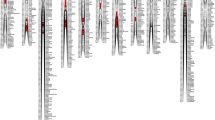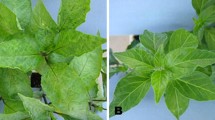Abstract
Tomato and potato expressed sequence tag (EST) sequences contained in the solanaceae genomics network (SGN) database were screened for simple sequence repeat (SSR) motifs. A total of 609 SSRs were identified and assayed on Solanum lycopersicum LA925 (formerly Lycopersicon esculentum) and S. pennellii LA716 (formerly L. pennellii). The SSRs that did not amplify, gave multiple band products, or did not exhibit a polymorphism that could be readily detected on standard agarose gels in either of these species were eliminated. A set of 76 SSRs meeting these criteria was then placed on the S. lycopersicum (LA925) × S. pennellii (LA716) high-density map. A set of 76 selected cleaved amplified polymorphism (CAP) markers was also developed and mapped onto the same population. These 152 PCR-based anchor markers are uniformly distributed and encompass 95% of the genome with an average spacing of 10.0 cM. These PCR-based markers were further used to characterize S. pennellii introgression lines (Eshed and Zamir, Genetics 141:1147–1162, 1995) and should prove helpful in utilizing these stocks for high-resolution mapping experiments. The majority of these anchor markers also exhibit polymorphism between S. lycopersicum and two wild species commonly used as parents for mapping experiments, S. pimpinellifolium (formerly L. pimpinellifolium) and S. habrochaites (formerly L. hirsutum), indicating that they will be useful for mapping in other interspecific populations. Sixty of the mapped SSRs plus another 49 microsatellites were tested for polymorphism in seven tomato cultivars, four S. lycopersicum var. cerasiforme accessions and eight accessions of five different wild tomato species. Polymorphism information content values were highest among the wild accessions, with as many as 13 alleles detected per locus over all accessions. Most of the SSRs (90%) had accession-specific alleles, with the most unique alleles and heterozygotes usually found in accessions of self-incompatible species. The markers should be a useful resource for qualitative and quantitative trait mapping, marker-assisted selection, germplasm identification, and genetic diversity studies in tomato. The genetic map and marker information can be found on SGN (http://www.sgn.cornell.edu).




Similar content being viewed by others
References
Akkaya MS, Bhagwat AA, Cregan PB (1992) Length polymorphisms of simple sequence repeat DNA in soybean. Genetics 132:1131–1139
Alvarez AE, van de Wiel CC, Smulders MJ, Vosman B (2001) Use of microsatellites to evaluate genetic diversity and species relationships in the genus Lycopersicon. Theor Appl Genet 103:1283–1292
Areshchenkova T, Ganal MW (1999) Long tomato microsatellites are predominantly associated with centromeric regions. Genome 42:536–544
Areshchenkova T, Ganal MW (2002) Comparative analysis of polymorphism and chromosomal location of tomato microsatellite markers isolated from different sources. Theor Appl Genet 104:229–235
Ashkenazi V, Chani E, Lavi U, Levy D, Hillel J, Veilleux RE (2001) Development of microsatellite markers in potato and their use in phylogenetic and fingerprinting analyses. Genome 44:50–62
Bernacchi D, Beck-Bunn T, Eshed Y, Lopez J, Petiard V, Uhlig J, Zamir D, Tanksley SD (1998a) Advanced backcross quantitative trait locus analysis of tomato. I. Identification of QTLs for traits of agronomic importance from L. hirsutum. Theor Appl Genet 97:381–397
Bernacchi D, Beck-Bunn T, Emmatty D, Eshed Y, Inai S, Lopez J, Petiard V, Sayama H, Uhlig J, Zamir D, Tanksley SD (1998b) Advanced backcross quantitative trait locus analysis of tomato. II Evaluation of near isogenic lines carrying single-donor introgressions for desirable wild QTL alleles derived from L. hirsutum and L. pimpinellifolium. Theor Appl Genet 97:1191–1196
Bernatzky R, Tanksley SD (1986) Toward a saturated linkage map in tomato based on isozymes and random complementary DNA sequences. Genetics 112:887–898
Blair MW, Panaud O, McCouch SR (1999) Inter-simple sequence repeat (ISSR) amplification for analysis of microsatellite motif frequency and fingerprinting in rice (Oryza sativa L.). Theor Appl Genet 98:780–792
Broun P, Tanksley SD (1996) Characterization and genetic mapping of simple repeat sequences in the tomato genome. Mol Gen Genet 250:39–49
Doganlar S, Frary A, Ku HK, Tanksley SD (2002) Mapping quantitative trait loci in inbred backcross lines of Lycopersicon pimpinellifolium (LA1589). Genome 45:1189–1202
Eshed Y, Zamir D (1995) An introgression-line population of Lycopersicon pennellii in the cultivated tomato enables the identification and fine mapping of yield-associated QTLs. Genetics 141:1147–1162
Frary A, Nesbitt TC, Frary A, Grandillo S, Van der Knaap E, Cong B, Lui J, Meller J, Elber R, Alpert KB, Tanksley SD (2000) fw2.2: a quantitative trait locus key to the evolution of tomato fruit size. Science 289:85–88
Fridman E, Pleban T, Zamir D (2000) A recombination hotspot delimits a wild species QTL for tomato sugar content to 484-bp within an invertase gene. Proc Natl Acad Sci USA 97:4718–4723
Fridman E, Liu YS, Carmel-Goren L, Gur A, Shoresh M, Pleban T, Eshed Y, Zamir D (2002) Two tightly linked QTLs modify tomato sugar content via different physiological pathways. Mol Genet Genomics 266:821–826
Fulton TM, Chunwongse J, Tanksley SD (1995) Microprep protocol for extraction of DNA from tomato and other herbaceous plants. Plant Mol Biol Rep 13:207–209
Fulton TM, Van der Hoeven R, Eannetta NT, Tanksley SD (2002) Identification, analysis and utilization of conserved ortholog set markers for comparative genomics in higher plants. Plant Cell 14:1457–1467
Grandillo S, Tanksley SD (1996a) Genetic analysis of RFLPs, GATA microsatellites and RAPDs in a cross between L. esculentum and L. pimpinellifolium. Theor Appl Genet 92:957–965
Grandillo S, Tanksley SD (1996b) Quantitative trait locus analysis of horticultural traits differentiating the cultivated tomato from the closely related species Lycopersicon pimpinellifolium. Theor Appl Genet 92:935–951
Haanstra JP, Wye C, Verbakel H, Meijer-Dekens F, van den Berg P, Odinot P, van Heusden AW, Tanksley S, Lindhout P, Peleman J (1999) An integrated high-density RFLP-AFLP map of tomato based on two Lycopersicon esculentum × L. pennelli F2 populations. Theor Appl Genet 99:254–271
He C, Poysa V, Yu K (2003) Development and characterization of simple sequence repeat (SSR) markers and their use in determining relationships among Lycopersicon esculentum cultivars. Theor Appl Genet 106:363–373
Jones DF (1917) Linkage in Lycopersicon. Am Nat 51:608–621
Jones ES, Dupal MP, Kölliker R, Drayton MC, Forster JW (2001) Development and characterization of simple sequence repeat (SSR) markers for perennial ryegrass (Lolium perenne L.). Theor Appl Genet 102:405–415
van der Knapp E, Tanksley SD (2001) Identification and characterization of a novel locus controlling early fruit development in tomato. Theor Appl Genet 103:353–358
van der Knapp E, Lippman ZB, Tanksley SD (2002) Extremely elongated tomato fruit controlled by four quantitative trait loci with epistatic interactions. Theor Appl Genet 104:241–247
Konieczny A, Ausubel FM (1993) A procedure for mapping Arabidopsis mutations using co-dominant ecotype-specific PCR-based markers. Plant J 4:403–410
Kosambi DD (1944) The estimation of map distances from recombination values. Ann Eugen 12:172–175
Ku HM, Doganlar S, Chen KY, Tanksley SD (1999) The genetic basis of pear-shaped tomato fruit. Theor Appl Genet 99:844–850
Lander ES, Green P, Abrahamson J, Barlow A, Daly MJ, Lincoln SE, Newburg L (1987) mapmaker: an interactive computer package for constructing primary genetic linkage maps of experimental and natural populations. Genomics 1:174–181
Martin GB, Williams JG, Tanksley SD (1991) Rapid identification of markers linked to a Pseudomonas resistance gene in tomato by using random primers and near-isogenic lines. Proc Natl Acad Sci USA 88:2336–2340
Martin GB, Brommonschenkel SH, Chunwongse J, Frary A, Ganal MW, Spivey R, Wu T, Earle ED, Tanksley SD (1993) Map-based cloning of a protein kinase gene conferring disease resistance in tomato. Science 262:1432–1436
Matsuoka Y, Mitchell SE, Kresovich S, Goodman M, Doebley J (2002) Microsatellites in Zea—variability, patterns of mutations and use for evolutionary studies. Theor Appl Genet 104:436–450
Miller JC, Tanksley SD (1990) RFLP analysis of phylogenetic relationships and genetic variation in the genus Lycopersicon. Theor Appl Genet 80:437–448
Monforte AJ, Tanksley SD (2000a) Development of a set of near isogenic and backcross recombinant inbred lines containing most of the Lycopersicon hirstum genome in a L. esculentum genetic background: a tool for gene mapping and gene discovery. Genome 43:803–813
Monforte AJ, Tanksley SD (2000b) Fine mapping of a quantitative trait locus from L. hirsutum chromosome 1 affecting fruit characteristics and agronomic traits: breaking linkage among QTLs affecting different traits and dissection of heterosis for yield. Theor Appl Genet 100:471–479
Morgante M, Olivieri AM (1993) PCR-amplified microsatellites as markers in plant genetics. Plant J 3:175–182
Nesbitt TC, Tanksley SD (2002) Comparative sequencing in the genus Lycopersicon: implications for the evolution of fruit size in the domestication of cultivated tomatoes. Genetics 162:365–379
Paterson AH, Lander ES, Hewitt JD, Peterson S, Lincoln SE, Tanksley SD (1988) Resolution of quantitative traits into Mendelian factors using a complete linkage map of restriction fragment polymorphism. Nature 335:721–726
Ronen G, Carmel-Goren L, Zamir D, Hirschberg J (2000) An alternative pathway to β-carotene formation in plant chromoplasts discovered by map-based cloning of Beta (B) and old-gold (og) color mutations in tomato. Proc Natl Acad Sci USA 97:11102–11107
Rozen S, Skaletsky HJ (1997) primer3. http://www-genome.wi.mit.edu/genome_software/other/primer3.html
Saal B, Wricke G (1999) Development of simple sequence repeats in rye (Secale cereale L.). Genome 42:964–972
Sela M, Budai-Hadrian O, Qilin P, Carmel-Goren L, Vunsch R, Zamir D, Fluhr R (2001) Genome-wide analysis for Fusarium resistance in tomato reveals multiple complex loci. Mol Genet Genomics 265:1104–1111
Smulders MJ, Bredemeijer G, Rus-Kortekaas W, Arens P, Vosman B (1997) Use of short microsatellites from database sequences to generate polymorphisms among Lycopersicon esculentum cultivars and accessions of other Lycopersicon species. Theor Appl Genet 97:264–272
Suliman-Pollatschek S, Kashkush K, Shats H, Hillel J, Lavi U (2002) Generation and mapping of AFLP, SSRs and SNPs in Lycopersicon esculentum. Cell Mol Biol Lett 7:583–597
Tadmor Y, Fridman E, Gur A, Larkov O, Ravid U, Zamir D, Lewinsohn E (2002) Identification of malodorous, a wild species allele affecting tomato aroma that was selected against during domestication. J Agric Food Chem 50:2005–2009
Tanksley SD, Ganal MW, Prince JP, deVicente MC, Bonierbale MW, Broun P, Fulton TM, Giovannoni JJ, Grandillo S, Martin GB, Messeguer R, Miller JC, Paterson AH, Pineda O, Roder MS, Wing RA, Wu W, Young ND (1992) High-density molecular linkage maps of the tomato and potato genomes. Genetics 132:1141–1160
Tanksley SD, Grandillo S, Fulton T, Zamir D, Eshed Y, Petiard Y, Lopez J, Beck-Bunn T (1996) Advanced backcross quantitative trait locus analysis in a cross between an elite processing line of tomato and its wild relative L. pimpinellifolium. Theor Appl Genet 92:213–224
Valdes AM, Slatkin M, Freimer NB (1993) Allele frequencies at microsatellite loci: the stepwise mutation model revisited. Genetics 133:737–749
Van der Hoeven R, Ronning C, Giovannoni J, Martin G, Tanksley S (2002) Deductions about the number, organization and evolution of genes in the tomato genome based on analysis of a large expressed sequence tag collection and selective genomic sequencing. Plant Cell 14:1441–1456
Wang Z, Weber JL, Zhong G, Tanksley SD (1994) Survey of plant short tandem DNA repeats. Theor Appl Genet 88:1–6
Young ND, Zamir D, Ganal MW, Tanksley SD (1988) Use of isogenic lines and simultaneous probing to identify DNA markers tightly linked to the Tm-2a gene in tomato. Genetics 120:579–586
Acknowledgements
We thank Dr. Amy Frary for valuable comments on the manuscript and Dane Rusçuklu and Evrim Balci for help with data analysis. This project was supported by grants from the National Science Foundation (DBI-0116076), the U.S. Department of Agriculture Plant Genome Program (9701552), and the Binational Agricultural Research and Development Fund (IS-3337-02).
Author information
Authors and Affiliations
Corresponding author
Additional information
Communicated by R. Hagemann
Rights and permissions
About this article
Cite this article
Frary, A., Xu, Y., Liu, J. et al. Development of a set of PCR-based anchor markers encompassing the tomato genome and evaluation of their usefulness for genetics and breeding experiments. Theor Appl Genet 111, 291–312 (2005). https://doi.org/10.1007/s00122-005-2023-7
Received:
Accepted:
Published:
Issue Date:
DOI: https://doi.org/10.1007/s00122-005-2023-7




